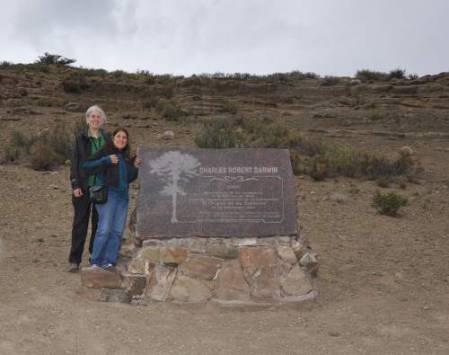The flight to Mendoza was short and sweet, and I was met by my colleague Iris Peralta, with whom I had written a monograph of the tomatoes and their wild relatives when she was in London on a post-doctoral fellowship in 2001. We spent the afternoon in the herbarium, looking at the Solanum and Nicotiana from Mendoza province to see where was best to go in the field over the next few days.
Our first field excursion was to the valley of Cerro Aconcagua. Pablo Molina, a new PhD student studying the phylogeny of cacti and their close relatives the purslanes (Portulacaceae) came with us to look for his plants as well! The peak of Aconcagua is at almost 7000 m above sea level, making it the tallest peak in South America. The area around Mendoza and into the high mountains is a high elevation desert – the vegetation is of shrubs and grasses, and at higher elevations vegetation is almost absent.
The vegetation on the way up the valley to Uspallata is dominated by creosote bush (Larraea); this genus also occurs in the deserts of California and Arizona in the USA
All along the roadsides in the disturbed soil we found Nicotiana noctiflora – we were early enough in the morning to see the flowers still open; at one site a nectar-robbing carpenter bee was carefully alighting on each flower and biting a hole in the base to suck out the nectar – this species flowers at night (hence the name!) and is pollinated by moths
Although the area is arid and dry, in winter it is snowy and the pass over the mountains to Chile (this is a major connection between the two countries) is often closed; all up and down the upper parts of the valley were ski areas, very popular in winter. The region has been shaped by the action of glaciers and landslides – ancient rockfalls and terraces were easy to see with the light vegetation cover.
We came to Puente del Inca – now I truly felt I was following Darwin around! After the Beagle had rounded the tip of South America, the ship suffered damage that had to be repaired. They docked in Valparaiso, Chile to repair the damage. Darwin took two men with him and rode over the Andes and then to Mendoza, riding back across the Andes into Chile along exactly the same valleys we were driving along. He described the unusual geological formation of the Puente del Inca beautifully in his book about the voyage of the Beagle.
The stone bridge over the river was formed from the concretion of chemicals from a thermal spring – this was the site of a thermal spa in the early 20th century with a posh hotel and baths. An avalanche completely destroyed the hotel (to the far right in the picture) but spared the church
Our first sight of Cerro Aconcagua came at Quebrada Horcones – it was a completely cloudless day – we were very lucky, the peak is often shrouded in clouds. What a mountain. Climbing it is tightly controlled – every year climbers die and they are buried in the “Cemeterio del Andinista” in the valley.
Quebrada Horcones is one of only a few places where climbers begin the ascent – apparently the record climbing time is 15 hours, incredibly speedy, most take longer and spend the night on the glaciers
Although we a lot of locality information for the Solanum and Nicotiana we were seeking, they were nowhere to be found. Like Patagonia, it was very dry, so we suspect it has been a bad year. We did find several of the purslane species Pablo and Iris were seeking though, on the way up an incredible set of switchbacks (called caracoles – snails – in Argentina) to a pass at 4000 metres.
Montiopsis andicola was named by John Gillies, a Scottish botanist who, between 1823 and 1828, explored this region botanically for the first time; this entire plant is smaller than a 5 pence coin!
The switchbacks to the statue of the “Cristo Redentor” were amazing – but the road had been fixed so it was full of cars and microbuses, the tourists in summer clothes had a shock at the top in the cold wind
Our amazing day ended with a new route back to Mendoza, along the way we collected some Fabiana for Iris’s PhD student at an amazing petroglyph site.
It had rained as we came down the valley from the high mountains and the resinous foliage of this species had a wonderful incense-y smell
Our last stop was at the plaque Iris and colleagues had organised to commemorate Darwin’s travels in the area. The plaque sits in the site of a petrified forest that Darwin described… it was quite moving to think of him on horseback seeing these same hills and the same vegetation. Seeing it myself brought it home to me how much his entire experience in South America must have shaped his ideas, not just the Galapagos.
Just behind the plaque we think we found the Solanum I was looking for, but only as tiny plants just breaking the soil….. frustrating, but I hope we find it elsewhere in the region, it seems to be common, but might just be fussy and not grow some years. What a day…. and at the very end, the mountain let us see it again from the top of the pre-cordillera, an ancient range just to the east of the Andes themselves, we were indeed very lucky!



